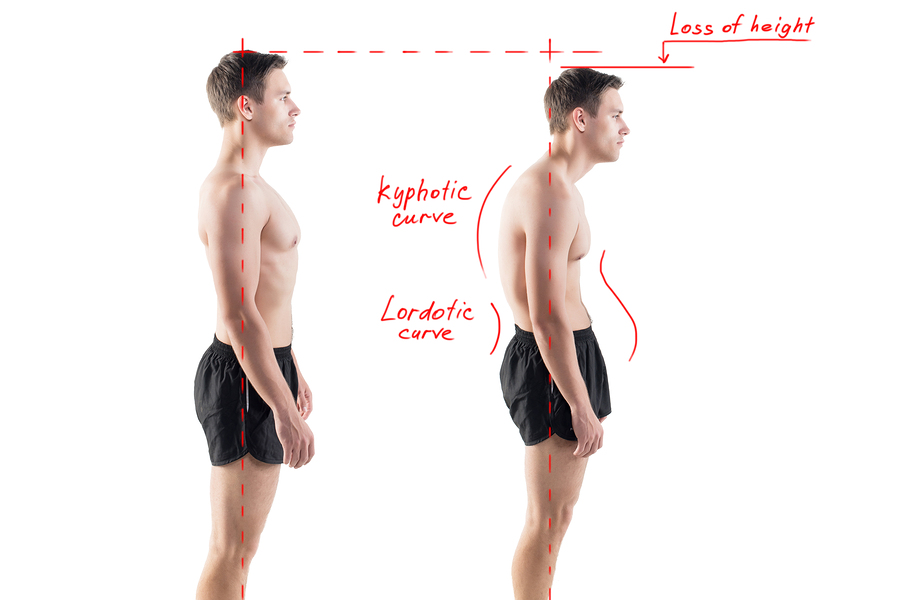Hey guys. Your family Chiropractor, Dr. Lell, here. Oregon City schools are back in and with that comes the school supplies, books, and assignments all overstuffed into that back-pack. If the backpack is too low or too heavy, it’s common to accommodate with bad posture (hyperkyphotic posture, to be clinically specific). The same bad posture that you’ll use when you’re hunched over your computer or looking down at your cell phone for the majority of your day. That’s how bad posture sets in. There’s not one random event or injury; bad posture is like bad teeth. It’s the end result of accumulated small neglects. It’s something you effortlessly slip into; one day realizing that you’re the person with bad posture.
If you think you’re developing bad posture, read this to find out.
But why does it matter anyway? Is there any consequence of bad posture beyond looking like someone with bad posture? Yes! Yes there is! As a Chiropractor, I’m always paying attention to a patient’s posture because beyond aesthetic, bad posture can cause difficulty breathing, shoulder injuries, and can shorten your life! How? Let’s find out!
BAD POSTURE CAN CAUSE POOR BREATHING, SHOULDER INJURIES, AND A SHORTER LIFE
Posture and Breath
Try this. Sit up nice and tall and take a deep breath. In and out. Now hunch over and repeat. Feel the difference?
The middle part of your spine, the thoracic spine, is attached to your rib cage. Know what’s in your rib cage? Your heart and lungs. When the thoracic spine is straight, the chest cavity is nice and open. The lungs can completely fill with air and the ribs can accommodate the expansion by moving up and down a little bit. But if you decrease the height of your thoracic spine (by hunching over) you make your chest cavity smaller. You can’t fill up your lungs enough. And your rib joints get crunched and can’t move as much to accommodate that expansion. Poor breathing can be linked to poor performance, anxiety, increased pain, and a dysfunctional core.
Posture and Shoulders
Okay time for another one. Sit up nice and tall. Now move your arms allllll the way up and reach for the ceiling. Okay arms down. Now hunch over and try again. See the difference? You shoulder, the glenohumeral joint, relies on many things to move the way it should. It especially relies on the the mobility of your thoracic spine and the stability of your shoulder blade (which in turn can depend on the mobility of the thoracic spine). So if your upper back doesn’t move the way it should (because it’s stiff and hunched forward), your shoulders won’t move properly either. This can set a person up for things like upper cross syndrome, thoracic outlet syndrome (numbness, tingling, weakness in arms and hands) and can make it easier for people to injure their rotator cuff, especially athletes.
Posture and Life Span
It might be surprising, but the bigger the hump in your back, the shorter your life. Many prospective observational studies have measured the degree of thoracic kyphosis in senior citizens in tracked their life spans over the next 15-35 years. What many of those researched found is that those with a stooped posture ended up dying a lot sooner than those without. They figure it has to do with the decreased heart and lung efficiency which increases the overall frailty of aged people.
So there you have it! The three surprising consequences of poor posture. If you have bad posture that you’d like to improve or if you’d like to maintain the good posture that you have, check out my favorite posture exercises.
As always, drop me a line on facebook if you have any questions or if you’d like to request a specific topic. And for more great information delivered right to you, sign up for my mailing list! A special thank you gift will be on its way when you do.
References
- Crawford. 1993. The influence of Thoracic Posture and and Movement on Range of Arm Elevation. Physiotherapy Theory and Practice. 9;3.
- Culham, E. 1994. Thoracic Kyphosis, Rib Mobility, and Lung Volumes in Normal Women and Women with Osteoporosis. Spine. 19;11.
